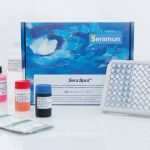Intended use:
The SeraSpot® Anti-Parvovirus-6 IgG / SeraSpot® Anti-Parvovirus-5 IgM test is an in vitro diagnostic device (spotimmunoassay, SIA) for the detection of Parvovirus-specific IgG or IgM antibodies in human serum or plasma samples.
General information:
In 1975, the human parvovirus B19 was discovered by chance in a blood donor test. The designation B19 is a result of the nomenclature used in this screening: the corresponding sample was the 19th serum in row B (1, 2). In 1983, the virus was detected in patients who had flu-like symptoms or aplastic crises. Since then, the human parvovirus B19 virus has been known to cause ringworm (Erythema infectiosum, also called Quintus disease or Fifth disease) (1, 3). It has now been proven that numerous other conditions may be associated with parvovirus B19 infection. These include arthritis and arthralgia (in 8% of infected children and 80% in adults), chronic anemia (in patients with leukemia and immunosuppressed patients), congenital anemia and rare forms of myocarditis, vasculitis and glomerulonephrithis (1).
Parvovirus B19 infection during pregnancy can cause complications in women without immune protection. Fetal deaths or hydrops fetalis (accumulation of fluid in compartments of the fetus) may be the result (1, 4, 5, 6, 7, 8, 9, 10). Parvovirus infections in children are 30% asymptomatic (6). Even in healthy adults, infection often has no apparent symptoms (5).
The human parvovirus B19 belongs to the family Parvoviridae. It is the only known human pathogenic parvovirus (10). The virus proliferates primarily in erythroid cells. It is a virus that has no lipid envelope and a diameter of 18 to 26 nm. The virus particles consist of 60 copies of the capsid protein and single- stranded DNA (5,596 nucleotides). The capsid protein is composed of the structural proteins VP-1 and VP-2. Portions of these structural proteins are referred to as VP-C and VP-N. In addition, the viral DNA encodes non-structural proteins. The major non-structural protein is designated NS-1 (1). This plays a role in viral replication and replication (12, 13).
Parvovirus transmission usually takes place via droplet infections, but infection routes via blood or blood products are also possible (1, 5). In the course of an infection, antibodies against the structural proteins VP-1 and VP-2 partly also form against the nonstructural protein NS-1 (11, 12, 13). IgM antibodies are present only at an early stage of infection, while parvovirus IgG antibodies are maintained throughout their lifetime (5). The prevalence rate in Germany is very high and is for example
Accessories:
| Art. No. | SP-012-6 G / SP-012-5 M |
|---|---|
| Sensitivity | IgG: 97 % IgM: 96 % |
| Specificity | IgG: 100 % IgM: 99 % |
Dear customers,
we have started to provide the documents for our products in an electronic format. These are the Instructions for Use (IFU), the Safety Data Sheets (SDS) and the Certificate of Analysis (CoA). For batches placed on the market after 01 January 2023, you can find our documents on the eIFU portal eifu.r-biopharm.com.










